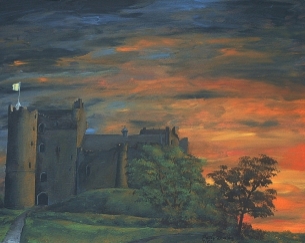Learn how to paint quickly and well. The instructor customizes assignments, based on ability and what the student is interested in. Patty has developed a painting instruction that breaks entirely new ground. She has adapted a painting method of the Renaissance painters, the gradual build-up of diluted color called “glazing,” to modern acrylics, which offer much easier clean-up and faster drying time than oils. As she has done for the drawing instruction, she has designed small gradual learning steps that go from simple subjects to highly advanced paintings. The fast drying time of acrylics is both an advantage and a disadvantage, allowing almost no time for blending, but she has found special ways to turn these versatile paints into an amazing art form.
Minimum Student Enrollment: 5
Course Length: 50 min class per week / 8 weeks/quarter
Cost: $93.50 per quarter 4
Supply list –
We will start painting practice as a homework assignment first. Most people do not naturally know how to use a paintbrush and need to practice for a while filling in shapes with colors. This needs to be mastered before learning to do three-dimensional modeling (shading something light-to-dark to make it look three-dimensional).
The following supplies are needed at the start of class:
No. 2 pencil
Eraser – A good quality eraser that erases well and doesn’t leave a residue.
Clear acetate – This is also used for tracing and then transferring images to the drawing paper. This can be something simple, like overhead projector pages or something similar from an office supply store. You just need a few of these, and a package can be shared with others.
Transfer paper – This is used to transfer images to the drawing paper or watercolor pad. See https://www.dickblick.com/products/saral-wax-free-transfer-paper/ You don’t need very much of this, because it can be reused, so one roll could be shared with other students.
Black (graphite). You don’t need very much of this, because it can be reused, so one roll could be shared with other students.
Small binder clip – This holds the sketch to the transfer paper to the drawing paper.
Paintbrushes – I have found that artificial hair brushes do not work very well, especially over time, for detailed painting. It is important that the bristles of the brush stay together and don’t start poking every which way. Definitely call me with any questions at 703-912-7649. This is the trickiest part of the supply list. The “Blick Scholastic” series is a nice compromise between the more expensive sable brushes and lower-quality artificial hair brushes (which can’t handle precision work). I have been surprised by how well this “art student” level brush works. Plus the prices are great for what you get. However, I couldn’t find the right bristle shape (it shouldn’t be too long) for the small bright brush in the Scholastic series.
Small round brush, sable. Here is one (https://www.dickblick.com/items/blick-scholastic-short-handle-red-sable-brush-round-size-1/)
Small flat brush called a “bright,” sable. One example: https://www.dickblick.com/items/silver-brush-renaissance-red-sable-brush-bright-long-handle-size-4/) One small flat brush that does not work well is the Dick Blick Master Series house brand. It tends to wear down to a nub too fast. Most other similar ones, however, should work fine.
Larger “bright” brush, sable (https://www.dickblick.com/items/blick-scholastic-red-sable-brush-bright-long-handle-size-16/). The size numbers are not uniform across brands and can be a bit confusing.
Also sometimes useful: smaller housepainting brush, if you happen to have one already.
“Scruffy” brush, about 1/2 inch wide. Synthetic bristles are fine. There could be a great alternative to buying one. A scruffy brush is a flat brush with bristles that are separated instead of staying together. This is usually a bad thing, but not for a painting technique I will teach the kids. You might already have a “bad” brush like this lying around the house. That will work fine. Link in case you don’t: https://www.amazon.com/Donna-Dewberry-One-Stroke-Brush-1-Scruffy/dp/B0007TZY3C/ref=sr_1_3?crid=1X1L4S5FLVUDK&keywords=scruffy+brush&qid=1676909456&sprefix=scruffy+brush%2Caps%2C365&sr=8-3
Paintbrush carrying case – good brushes require good care, including making sure the bristles don’t get damaged while transported. Here are several possibilities: https://www.dickblick.com/categories/brushes/holders/ The jury is still out on which kind is best. Remember that you might have both short- and long-handled brushes. The roll-up approach doesn’t seem to work very well. Maybe a box or “wallet.”
Palette – Ceramic palettes are easier to clean than plastic palettes. Here is one: https://www.dickblick.com/items/porcelain-palette-x-1-18-x-7-18-7-wells-round/
Palette container – A plastic kitchen container that fits the palette, to keep the paint from drying out.
Palette knife – This is for moving paint around and blending colors. https://www.dickblick.com/items/blick-painting-knife-3-flat/ There is something weird going on with the photo of the palette knife here. The little photo on the side is accurate.
Rag – Whatever is around the house. Not real big.
Paint shirt – Figure young artists are messy.
- Paints – I have had great results with Ceramcoat jar acrylic paint. Dick Blick doesn’t sell them. They are sold on the Joann site: https://www.joann.com/delta-ceramcoat-acrylic-paint-2-oz/3317997.html 2 oz is fine. They are also sold many other places.
- When choosing colors to buy, use this formula: Find first the eight bright colors in a pack of crayons. Add white.
- Whenever you want to buy more colors of paint or pencils, do so in this order:
- leaf green (different from bright green), dark burnt umber (a type of brown), grayish blue, ivory, pink, gray, light blue, dark forest green, and yellow-green.
- This is based on how often I have seen the need for the color. They can all be mixed from the original 8 colors plus white, but it’s more effort.
Watercolor block – A small 5″ x 7″ and a 9″ x 12″ would be good. The sheets stay attached with adhesive on the sides until you take them off. This keeps the paper stretched while it dries and it doesn’t warp. Hot-pressed watercolor paper is smoother and better for many techniques. Here is one: https://www.dickblick.com/items/fabriano-artistico-enhanced-watercolor-block-extra-white-hot-press-5-x-7/ Other painting surfaces may be needed in the future for large-scale projects.
Glazing liquid – This is used for blending techniques. Here is what I have used: https://www.dickblick.com/items/golden-acrylic-glazing-liquid-satin-8-oz-bottle/
Dye-na-flow paint – Black and brown. This is a smooth-flowing liquid paint that, mixed with glazing liquid, can be used for advanced blending techniques. Warning: The small jars are not air-tight in the long run. I found out the hard way. Either transfer the paint to the ink bottles (below) or wind electrical tape around the edge of the lid and jar when already opened but not in use for a while. https://www.dickblick.com/products/jacquard-dye-na-flow-fabric-colors/ This is a very useful paint (a shame about the jars) and the young artist might want more colors at some point. The large jars seem to be airtight.
Ink bottles – See https://www.dickblick.com/items/glass-jar-wdropper-each/ These are for putting the Dye-na-flow paints in since it is impossible to move the paint into the palettes otherwise.
Colored pencils – Black, brown, maybe ochre for fur on animals. I have found this often works well on top of light-colored paint. You can buy individual pencils. Prismacolor is a good brand. https://www.dickblick.com/products/prismacolor-premier-colored-pencils/
Tote bag – To carry all this stuff.


